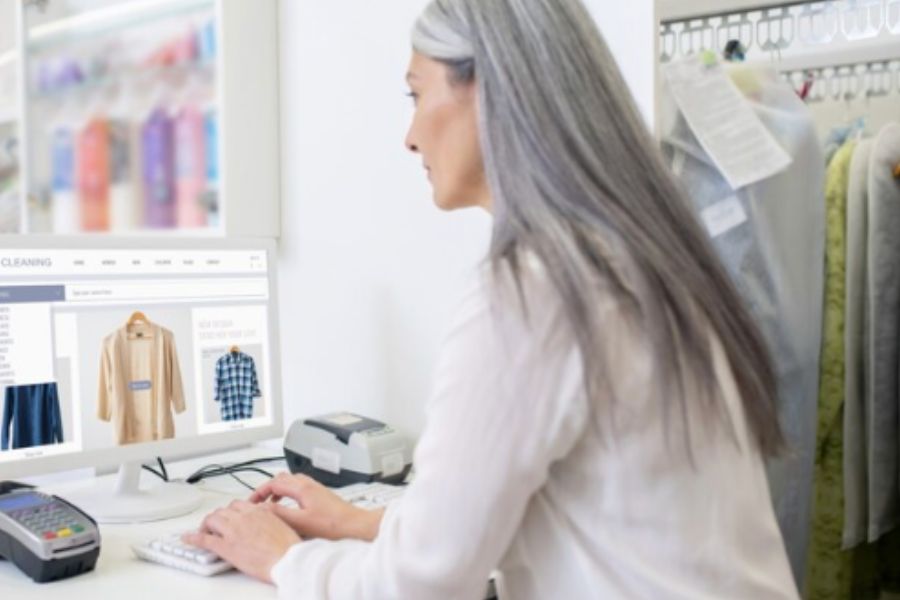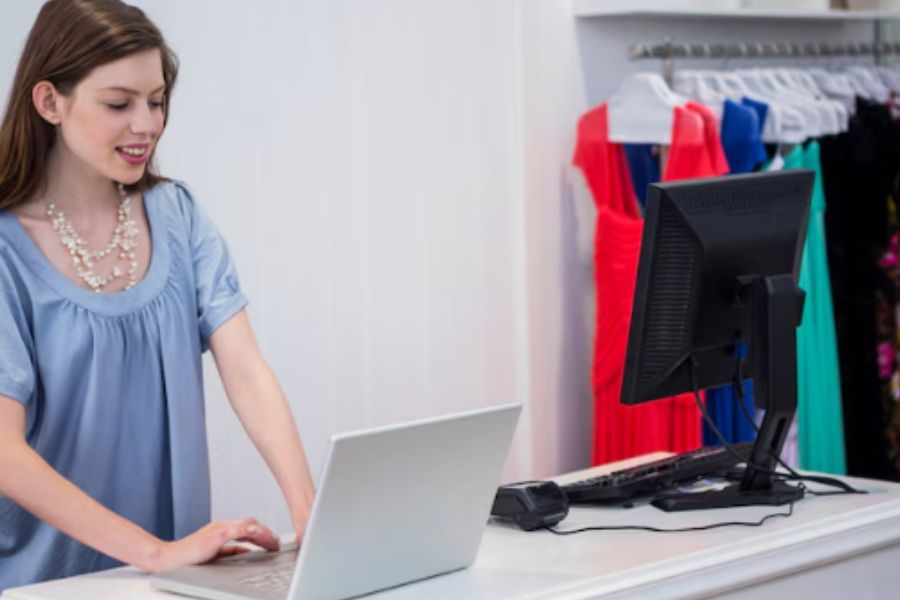We have talked about many aspects of a POS system in the commerce industry, such as how much a POS supports you as business owners and operators, and even how much a POS costs. However, if all of that knowledge hasn’t fulfilled you enough because of its generality, we’re here to fix that together. In today’s article, we’ll learn everything you want to know about how a POS system supports your fashion brands. And a case study of VMart will be provided later on to make everything even clearer.
Biggest challenges facing fashion retailers
Poor in-store experience that lacks personalization
It is a fact that retailers have focused so much on their e-commerce and omnichannel strategies that they are likely to forget about using technology within their physical retail stores to inspire and educate customers. Research has indicated more than 60% of consumers use digital content from social media, magazines, fashion shows, etc. to make shopping decisions, but this kind of content is lacking in the in-store shopping experience.
Demand for instant fulfillment
These days, customers demand a kind of ‘now-or-never’ service as the majority of them are willing to pay more for same-day delivery. In fact, one of the main reasons behind many shopping cart abandonment is that customers see shipping as ‘too low’. Therefore, it’s high time retailers offered next- or same-day delivery. The barrier to providing faster shipping to customers is the time and effort that integration with last-mile delivery partners requires.
Unsold stock
Being an extremely intuitive and time-sensitive industry, one of the toughest challenges that fashion brands face particularly is a huge amount of unsold stock due to going out of style, fitting issues, end-of-season situation, etc. Brands are struggling understanding customers’ preferences as the buying habits of Millennials and Gen-Z change more frequently than generations prior. A deep and insightful understanding of the history, current trends, and future inclinations are vital to apparel retailers.
Warehouse worker checking inventory on a metal rack on a robot. Stock taking job. Modern flat style vector illustration isolated on white.
More interest in online shopping
Over the last few years, e-commerce has become an indispensable part of global retail. According to Statista, in 2019, an estimated 1.92 billion people purchased goods or services online. During the same year, e-retail sales surpassed 3.5 trillion U.S. dollars worldwide, and according to the latest calculations, e-commerce growth will accelerate even further in the future.
But, the problem of retail is much deeper. The main reason behind the public fondness toward e-commerce is its simple return policies. These make online shopping cheap, light, and risk-free when selling clothes, which is currently the largest category of e-commerce. The success of start-up e-commerce businesses forced retailers in physical stores to offer similar conditions and aim for the same convenience as found online.
How a POS system helps fashion brands deal with the problems
Inventory control
With this feature in POS systems, your fashion brands can record and update stock information including stock-outs and discrepancies, track supply movement, get data on details related to product costs, and profit margins. Moreover, this feature includes automatically updating the stock replacements or refills required, and directing store deliveries.
Additionally, you can take your inventory and logistics management capability to the next level with merchandising reports. This helps analyze items, sales history, and keep track of dead stock, slow-moving stock, and best-sellers. As apparel retail brands usually have several outlets, this attribute helps to make communication among them regarding stocks, inventory, and inter-store transfers.
Customer relationship management (CRM)
The information that fashion brands value the most yet is using the worst is the customer database. That’s why this feature is here to help as not only does it track every detail of a customer (name, address, measurements, birthdays, anniversaries, buying habits, etc.), but it also allows the sales executives to enter notes to provide better customer service and build better relationships. Having data beyond sales, and taking care of customers by knowing specific details keeps them coming back.
Furthermore, with a large enough database, you, as business owners and operators, can get meaningful and valuable insights into buyers’ behaviors and psychology, and identify current trends or predict trends accordingly. You can even treat your customers better and keep them coming back with integrated features like reward points and gift cards in a POS.
E-commerce
Through this feature, retailers can coerce their e-commerce platform. It allows uploading data related to inventory, customers, and prices to online stores and at the same time downloads customer orders, for further processing. A POS system supports your fashion brands by facilitating the e-commerce expansion with various useful and handy functions, two of which worth mentioning are:
- Consumer apps to improve the shopping experience for customers. By developing consumer apps, sellers now can have their customers making purchases online anywhere at any time, right on their own mobile devices. More than that, consumer apps also help with up-selling and cross-selling triggered by personalized product recommendations.
Personalized product recommendations in PWA consumer apps.
- Social commerce enables customers to buy products right at the moment they encounter it on social media. According to research, 51% of millennials tend to buy products via social media. By a POS system embeds purchase buttons into social media platforms like Instagram, Facebook, or Twitter, it increases the chance of customers adding the product into their carts. For example, the introduction of Instagram Shopping Posts in 2018 started a whole new era of social commerce and e-commerce in general.
Various shipping methods that are fast
Shipping is a mundane and everyday task of every retailer that offers online shopping or sells on the phone. However, it consumes so much time and effort for business owners and operators to optimize their shipping as there are many processes to deal with. Furthermore, buyers nowadays want to be capable of doing more: they want their purchases to be shipped from brick-and-mortar stores or from warehouses. And no matter the shipping option, customers want it to be fast.
POS systems support fashion brands with shipping from figuring out the best fulfillment route to splitting orders and figuring out the optimal safety stock. Additionally, shipping is now at ease as POS helps retailers provide customers with various shipping options, point out the shortest route from a warehouse or physical store to customers’ addresses, and communicate well with shippers. All are for a smooth and seamless delivery process that pleases the customers.
Technology enhancing in-store experience
It has become a trend of retailers to leverage technology-advanced POS systems to create a shopping experience and an entertaining adventure for their customers in-store.
Today, POS is so technologically advanced that it can support fashion brands with up-selling and cross-selling thanks to the integrated AI facial recognition feature. With AI facial recognition, staff can be informed at the very moment that a customer walks in. Furthermore, as it recognizes customers by their faces, AI allows store assistants to review customers’ cart history, buying patterns, wish lists, etc. Based on the information, the staff can know how to make suitable personalized product recommendations for each customer.
Take a step further, AI facial recognition in POS also creates a novelty and exciting experience for customers to actively support fashion brands. For example, some stores are adopting this technology to make personalized product recommendations based on customers’ information (like gender, age,..) identified through face reading.
Case study: VMart
One of the great examples of a POS supporting a fashion brand is VMart. VMart is an Indian fashion brand that offers a wide range of clothing for men, women, and kids. The brand is such a tech-savvy retailer as it always has kept technology at the forefront of everything and is looking for a complete solution. From its very beginning, V-Mart has been using a POS system to manage its business elements, including purchase, distribution, accounts, etc. Over the years, VMart has expanded its POS solution to vendor shipment portals, store auto-replenishment, and most importantly, business intelligence (comprising the strategies and technologies used by enterprises for the data analysis of business information). Currently, VMart has opened over 140 hypermarkets and doesn’t seem to stop as they want to expand their national reach, with the help from their POS solution.
Optimizing supply chain
- Improved the average inventory sales days from 86 to 81 days for faster replenishment of merchandise with the latest trends
- Express delivery from the centralized distribution center to the north-east for the sustenance of store freshness
- Capacity building at the warehouse for catering to growth requirements the operations
- Launched an automated online requirement portal and requests management system for enhancing efficiency and serving internal customers
Building robust and future-ready operations
- Placed new locations strategically within 50-150 km radius from existing cities for rapid scalability and supply chain efficiencies.
- Entered the digital ecosystem by setting up an organization-wide data analytics platform and developing analytics that makes the system more agile and responsive.
- Launched a unified staff management system for better human resource management.
- Improved technical capabilities by launching mobile POS machines at stores.
- Launched a fully integrated CRM & loyalty platform.
- Developed VMart consumer app.
VMart consumer app
Embracing digital channel – Launching omnichannel
VMart is designing a 360 omnichannel experience seamlessly integrated across the entire customer lifecycle to deliver a digital experience at the stores and to online consumers. For responding to an intensifying competition that is also witnessing the entry of global e-retailers your company aims to unlock and serve the aspirations of more digitally aware customers in all part of the country
Final words,
Being one of the most aesthetic and intuitive industries, it’s common seeing fashion brands struggling with not only keeping their business together but also constantly changing to meet the customers’ expectations. That’s when a POS system comes to the rescue. With such a POS system, fashion brand operators like you can manage your business more efficiently while living your best life. At ConnectPOS, we have all the sources and abilities to be that POS system for the success of your fashion brands. Our POS is technologically advanced and deemed one of the best cloud-based POS software trusted by an innumerable number of retailers worldwide. See the lists of POS features supporting particularly the fashion businesses here. Contact us, or book your 14-day free trial now to experience our globally standard service!



